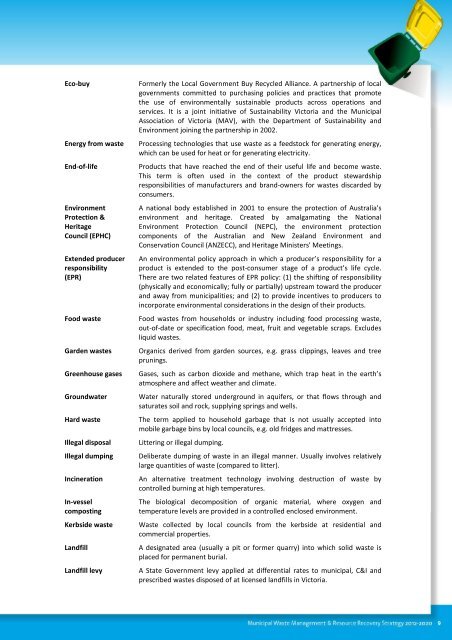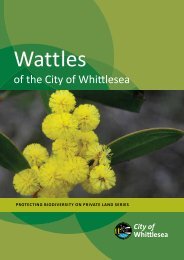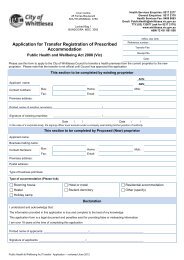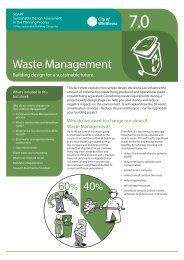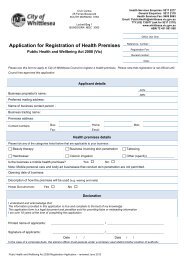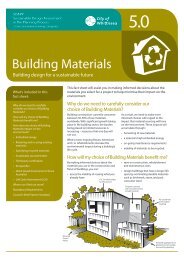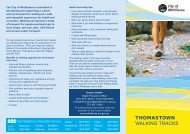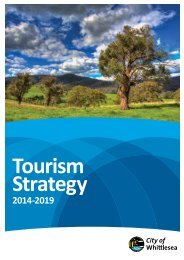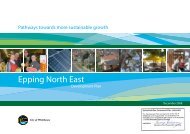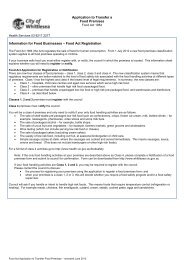Waste Management Strategy - full version - City of Whittlesea
Waste Management Strategy - full version - City of Whittlesea
Waste Management Strategy - full version - City of Whittlesea
Create successful ePaper yourself
Turn your PDF publications into a flip-book with our unique Google optimized e-Paper software.
Eco-buyEnergy from wasteEnd-<strong>of</strong>-lifeEnvironmentProtection &HeritageCouncil (EPHC)Extended producerresponsibility(EPR)Food wasteGarden wastesGreenhouse gasesGroundwaterHard wasteIllegal disposalIllegal dumpingIncinerationIn-vesselcompostingKerbside wasteLandfillLandfill levyFormerly the Local Government Buy Recycled Alliance. A partnership <strong>of</strong> localgovernments committed to purchasing policies and practices that promotethe use <strong>of</strong> environmentally sustainable products across operations andservices. It is a joint initiative <strong>of</strong> Sustainability Victoria and the MunicipalAssociation <strong>of</strong> Victoria (MAV), with the Department <strong>of</strong> Sustainability andEnvironment joining the partnership in 2002.Processing technologies that use waste as a feedstock for generating energy,which can be used for heat or for generating electricity.Products that have reached the end <strong>of</strong> their useful life and become waste.This term is <strong>of</strong>ten used in the context <strong>of</strong> the product stewardshipresponsibilities <strong>of</strong> manufacturers and brand-owners for wastes discarded byconsumers.A national body established in 2001 to ensure the protection <strong>of</strong> Australia'senvironment and heritage. Created by amalgamating the NationalEnvironment Protection Council (NEPC), the environment protectioncomponents <strong>of</strong> the Australian and New Zealand Environment andConservation Council (ANZECC), and Heritage Ministers' Meetings.An environmental policy approach in which a producer’s responsibility for aproduct is extended to the post-consumer stage <strong>of</strong> a product’s life cycle.There are two related features <strong>of</strong> EPR policy: (1) the shifting <strong>of</strong> responsibility(physically and economically; <strong>full</strong>y or partially) upstream toward the producerand away from municipalities; and (2) to provide incentives to producers toincorporate environmental considerations in the design <strong>of</strong> their products.Food wastes from households or industry including food processing waste,out-<strong>of</strong>-date or specification food, meat, fruit and vegetable scraps. Excludesliquid wastes.Organics derived from garden sources, e.g. grass clippings, leaves and treeprunings.Gases, such as carbon dioxide and methane, which trap heat in the earth’satmosphere and affect weather and climate.Water naturally stored underground in aquifers, or that flows through andsaturates soil and rock, supplying springs and wells.The term applied to household garbage that is not usually accepted intomobile garbage bins by local councils, e.g. old fridges and mattresses.Littering or illegal dumping.Deliberate dumping <strong>of</strong> waste in an illegal manner. Usually involves relativelylarge quantities <strong>of</strong> waste (compared to litter).An alternative treatment technology involving destruction <strong>of</strong> waste bycontrolled burning at high temperatures.The biological decomposition <strong>of</strong> organic material, where oxygen andtemperature levels are provided in a controlled enclosed environment.<strong>Waste</strong> collected by local councils from the kerbside at residential andcommercial properties.A designated area (usually a pit or former quarry) into which solid waste isplaced for permanent burial.A State Government levy applied at differential rates to municipal, C&I andprescribed wastes disposed <strong>of</strong> at licensed landfills in Victoria.9


